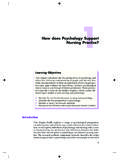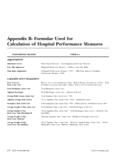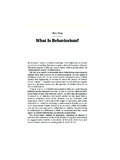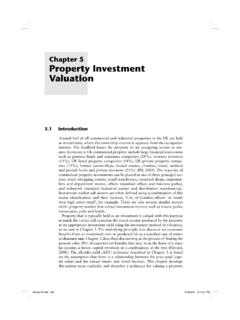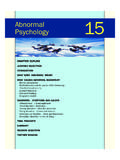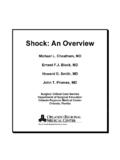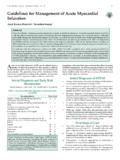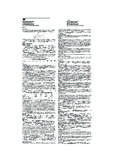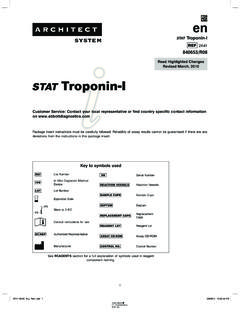Transcription of Pathophysiology of acute myocardial infarction
1 88 Pathology and therapeuticsInfarctionis tissue death caused by ischaemia. acute myo-cardial infarction (MI) occurs when localized myocardialischaemia causes the development of a defined region of nec-rosis. MI is most often caused by rupture of an atheroscleroticlesion in a coronary artery. This causes the formation of a throm-bus that plugs the artery, stopping it from supplying blood to theregion of the heart that it of thrombosis in MIPivotal studies by DeWood and colleagues showed that coron-ary thrombosisis the critical event resulting in MI. Of patientspresenting within 4 h of symptom onset with ECG evidence of transmural MI, coronary angiography showed that 87% hadcomplete thrombotic occlusion of the infarct-related artery. Theincidence of total occlusion fell to 65% 12 24 h after symptomonset due to spontaneous fibrinolysis. Fresh thrombi on top of ruptured plaques have also been demonstrated in the infarct-related arteries in patients dying of and consequences of plaque ruptureCoronary plaques which are prone to rupture are typically smalland nonobstructive, with a large lipid-rich core covered by a thinfibrous cap.
2 Activated macrophagesand T- lymphocyteslocalizedat the site of plaque rupture are thought to release metalloproteasesand cytokineswhich weaken the fibrous cap, rendering it liableto tear or erode due to the shear stress exerted by the of acute myocardial infarction41 EndocardiumFibrous capLipid coreMacrophagesand T-lymphocytes0 hCross-section of ventricular wallserved by thrombosed arteryThrombus propagatesinto and alongcoronary arteryPlaque rupture,platelet aggregationSubendocardial necrosed zoneCellular damage progressing, butstill partially reversible with reperfusionTransmural necrosed zoneInfarct appears pale, most cells dead,neutrophils present coagulation necrosisMainly deadmyocytes andneutrophilsScarthinfirmgreyGranulatio n tissuemoves inward andreplaces dead tissuewith scar tissueFinish hereStart hereMixture of living and dead myocytes; substrate for re-entrantarrhythmiasStunned myocardium2 h24 h5 7 days> 3 23/10/03 5:42 PM Page 88 Pathophysiology of acute myocardial infarction89 Plaque rupture reveals subendothelial collagen, which serves as a site of platelet adhesion, activation and aggregation.
3 Thisresults in:1 The release of substances such as thromboxane A2(TXA2),fibrinogen, 5-hydroxytryptamine (5-HT), platelet activating fac-torand ADP, which further promote platelet of the clotting cascade, leading to fibrin formationand propagation and stabilization of the occlusive endothelium is often damaged around areas of coronaryartery disease. The resulting deficit of antithrombotic factorssuch as thrombomodulinand prostacyclinenhances thrombusformation. In addition, the tendency of several platelet-derivedfactors ( TXA2, 5-HT) to cause vasoconstriction is increasedin the absence of endothelial-derived relaxing factors. This maypromote the development of local vasospasm, which worsenscoronary death and acute coronary syndrome onset show a circadian variation(daily cycle), peaking at around 9 witha trough at around 11 Levels of catecholamines peak aboutan hour after awakening in the morning, resulting in maximallevels of platelet aggregability, vascular tone, heart rate andblood pressure, which may trigger plaque rupture and physical and mental stress can also cause MI and sudden death, supporting a role for increases in catecholaminesin MI Pathophysiology .
4 Furthermore, chronic -adrenergicreceptor blockade abolishes the circadian rhythm of of young subjects killed in road accidents oftenshow small plaque ruptures in susceptible arteries, suggestingthat plaque rupture does not always have pathological con-sequences. The degree of coronary occlusion and myocardialdamage caused by plaque rupture probably depends on systemiccatecholamine levels, as well as local factors such as plaquelocation and morphology, the depth of plaque rupture, and theextent to which coronary vasoconstriction and prolonged ischaemia produces a region of nec-rosis spanning the entire thickness of the myocardial wall. Sucha transmuralinfarct usually causes ST segment elevation ( , see Chapter 38). Less severe and protracted ischaemiacan arise when:1 Coronary occlusion is followed by spontaneous infarct-related artery is not completely is complete, but an existing collateral blood supplyprevents complete ischaemia.
5 4 The oxygen demand in the affected zone of myocardium these conditions, the necrotic zone may be mainly limitedto the subendocardium, typically causing non-ST segment eleva-tion classification of acute MI according to the presence orabsence of ST segment elevation is designed to allow rapid de-cision-making concerning whether thrombolysis should be initiated (see Chapter 42). This classification replaces the pre-vious one, based on the presence or absence of Q waves on theECG, which was less useful for guiding immediate of the infarctBoth infarcted and unaffected myocardial regions undergo progressive changes over the hours, days and weeks followingcoronary thrombosis. This process of postinfarct myocardialevolution leads to the occurrence of characteristic complicationsat predictable times after the initial event (see Chapter 42).Ischaemia causes an immediate loss of contractility in theaffected myocardium, a condition termed hypokinesis.
6 Necrosisstarts to develop in the subendocardium (which is most prone toischaemia; see Chapter 37), about 15 30 min after coronary occlu-sion. The necrotic region grows outward towards the epicardiumover the next 3 6 h, eventually spanning the entire ventricularwall. In some areas (generally at the edges of the infarct) themyocardium is stunned(reversibly damaged) and will eventuallyrecover if bloodflow is restored. Contractility in the remainingviable myocardium increases, a process termed progression of cellular, histological and gross changesdevelop within the infarct. Although alterations in the grossappearance of infarcted tissue are not apparent for at least 6 hafter the onset of cell death, cell biochemistry and ultrastructurebegin to show abnormalities within 20 min. Cell damage is pro-gressive, becomingly increasingly irreversible over about 12 period therefore provides a window of opportunity duringwhich thrombolysis and reperfusion may salvage some of theinfarct (see Chapter 43).
7 Between 4 and 12 h after cell death starts, the infarctedmyocardium begins to undergocoagulation necrosis, a pro-cess characterized by cell swelling, organelle breakdown andprotein denaturation. After about 18 h, neutrophils(phagocyticlymphocytes) enter the infarct. Their numbers reach a peak afterabout 5 days, and then decline. After 3 4 days, granulation tis-sueappears at the edges of the infarct zone. This consists ofmacrophages, fibroblasts, which lay down scar tissue, and newcapillaries. The infarcted myocardium is especially soft be-tween 4 and 7 days, and is therefore maximally prone to ruptur-ing. This event is usually fatal, may occur at any time during thefirst 2 weeks and is responsible for about 10% of MI the granulation tissue migrates inward toward the centre ofthe infarct over several weeks, the necrotic tissue is engulfedand digested by the macrophages. The granulation tissue thenprogressively matures, with an increase in connective (scar) tissue and loss of capillaries.
8 After 2 3 months, the infarct hashealed, leaving a noncontracting region of the ventricular wallthat is thinned, firm and pale expansion, the stretching and thinning of the infarctedwall, may occur within the first day or so after a MI, especially if the infarction is large or transmural, or has an anterior loca-tion. Over the course of several months, there is progressive dilatation, not only of the infarct zone, but also of healthymyocardium. This process of ventricular remodellingiscaused by an increase in end-diastolic wall stress. Infarct expan-sion puts patients at a sub-stantial risk for the development ofcongestive heart failure, ventricular arrhythmias, and free wallrupture. ACSC41 23/10/03 5:42 PM Page 89




